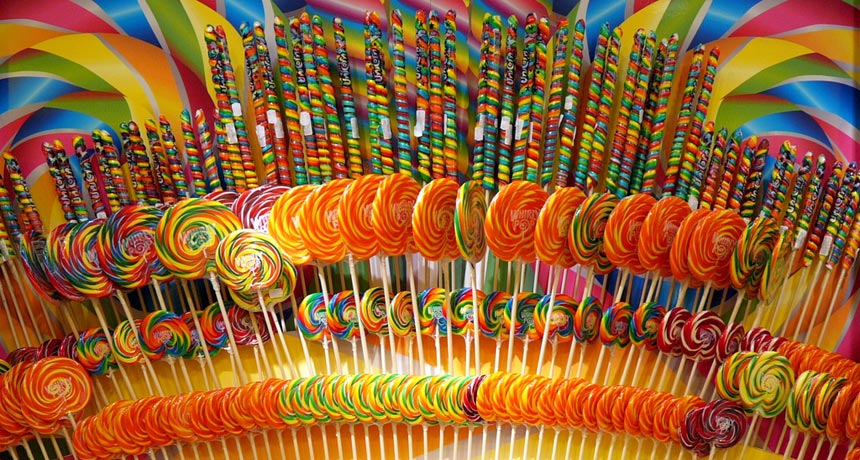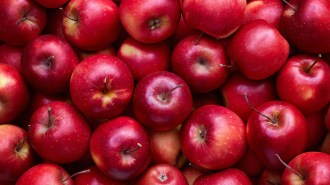Diet and nutrition is more complex than a simple sugar
Sugar study says a lot about our bodies and little about our diet

A new study shows that the simple sugar fructose has different effects on human behavior than glucose. But it’s doesn’t tell us much about what those lollipops will do to our health or behavior.
Swamibu/Flickr (CC BY-NC 2.0)
- More than 2 years ago
When it comes to studying the vast complexity of the food we eat, it helps to simplify. Test one nutrient or variable at a time to find out how each functions. Compare one part of a sugar molecule against another. These studies can tell us a great deal about how specific nutrients are processed in the body, and how they affect our health, our waistlines and even our behavior.
But one thing many of these single-nutrient studies don’t tell us? Anything about the food we actually eat.
A new study shows that a hit of fructose — the simple sugar common in fruits, vegetables and honey — leaves people hankering for a snack more than a similar hit of glucose, the simple sugar taken up directly by our muscles and brain. But while the results can tell scientists something about how the body responds to glucose and fructose, they have very little to say about the apples in your diet.
Fructose and glucose are both monosaccharides, the most basic unit of a carbohydrate. Combine the two together in equal amounts for basic table sugar. Mix 55 percent fructose with glucose and water for high-fructose corn syrup. Glucose is the energy source our cells prefer (especially the cells in the brain). Fructose is glucose’s sweeter cousin.
While glucose stimulates the release of insulin and circulates in the blood for uptake by muscles and the brain, fructose is broken down by the liver. Because fructose does not stimulate insulin — beginning the cascade of hormonal responses that end in feelings of fullness — high levels of fructose may not be as satisfying as glucose, leading people to eat more to feel satisfied. This in turn might mean that higher levels of fructose may play some role in increasing waistlines.
But to understand if there is any role of fructose in obesity, scientists first need to understand how our appetites respond to its presence. “We wanted to understand brain reward pathways and eating behavior,” explains endocrinologist Kathleen Page, of the University of Southern California in Los Angeles and coauthor of the new study, published May 19 in the Proceedings of the National Academy of Sciences. “If we’re going to understand how each [dietary] component works to understand how they modify appetite, we have to look at them separately first.”
So Page and her colleagues recruited 24 volunteers to, on three separate mornings, drink water, water sweetened with 75 grams (the mass of a little over a third of a cup of table sugar) of glucose or water with the same dose of fructose. The volunteers ranked how hungry they were before and after consuming the drinks.
Then, while lying in an fMRI scanner, volunteers were shown images of food with a dollar amount for how much the food cost. They could rank whether they wanted the pictured food now, or whether they would wait to receive the money instead of the food. “We wanted to mimic a real-world situation where the benefits of turning down high-calorie foods come later in the benefits of weight maintenance,” Page explains.
The results showed that fructose and glucose have different effects on both body and behavior. Fructose did not reduce hunger as much as glucose. After the volunteers drank fructose drinks, they were willing to pay slightly more money (about $1.45 more) for a snack than when they drank glucose. After fructose drinks, the fMRI scans showed that participants had more activity in the visual cortex than after glucose, and they had more activity in reward-related brain areas such as the orbitofrontal cortex and striatum.
Blood tests showed that glucose caused a large increase in blood insulin. But fructose is cleared out of the blood quickly and broken down in the liver, and does not stimulate insulin very much at all. The authors think this might be part of the reason why fructose tended to leave the participants hungry for more, while glucose, which stimulates insulin production, kept them relatively satisfied.
Along with Page’s previous study looking at fructose, glucose and brain blood flow, “it forms a nice story suggesting that there are two different mechanisms controlling fructose and glucose,” says Jacki Rorabaugh, a neuropharmacologist at Emory University in Atlanta. “Maybe down the line it could give us more drug or behavioral targets to try and curb sugar intake.”
To many diet gurus, fructose is the devil du jour. Particularly in the form of high-fructose corn syrup, fructose is thought to contribute to the rising obesity rates in the United States and elsewhere. But while this study does show that pure fructose leaves a hungry study subject wanting more, it’s just one step toward understanding the complexities of fructose’s role in human diets.
“As far as how you [apply this to] public health, it’s limited,” Rorabaugh explains. “You can buy pure fructose and pure glucose, but in the majority of sugars we consume, you get both at the same time.” Fructose may have different effects in the brain, Rorabaugh says, but “is that extra effect so strong it overrides the glucose? That’s a different study that still needs to be done.”
The doses used in the experiment are also a lot higher than most people would ever consume on their own, notes Luc Tappy, who studies human nutrition at the University of Lausanne in Switzerland. Seventy-five grams of pure fructose, he points out, is half of a 150-gram dose of table sugar, and that amount of sugar has almost 600 calories. It’s a lot of sweet in one single drink. So while he agrees that studying how the body processes glucose and fructose is extremely important, “I would, however, be very careful [not] to jump to definitive conclusions.” Lower, more realistic doses of fructose may not have significant effects.
Many people want scientific studies to offer one single answer on what they should eat. They want to know that if they add or eliminate just one thing, all their health problems will be solved. Maybe they should eat only unprocessed foods, ditch carbs or avoid foods high in fructose, such as fruit. But the reality is almost always more complicated. Our brains and bodies are almost never exposed to pure glucose or fructose. Instead they are presented with sugars, salts, fats and proteins, all providing their own set of information to the body.
Next up, Page says, is a study of differences in the effects of sucrose and high-fructose corn syrup on the brain and behavior. “Those have more real-world implications,” Page says. She also says that she would like to examine long-term effects of different monosaccharides as opposed to a lone sugary dose. But while fructose alone may have its health problems, nutrition is always going to be more complex than a single simple sugar.






